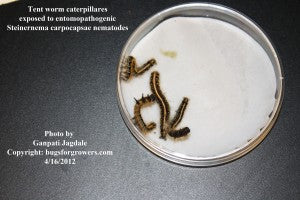Susceptibility of black cutworms to beneficial nematodes
In my last blog post, I demonstrated the cutworms were susceptible to beneficial entomopathogenic Steinernema carpocapsae nematodes. These results are confirmed by a recent finding of Ebssa and Koppenhofer (2012), who also demonstrated that the Steinernema carpocapsae nematodes were highly effective against cutworm Agrotis ipsilon. These researchers also demonstrated that the other species of beneficial nematodes including Heterorhabditis bacteriophora, Heterorhabditis megidis and Steinernema riobrave were effective in killing larval stages of cutworms.











